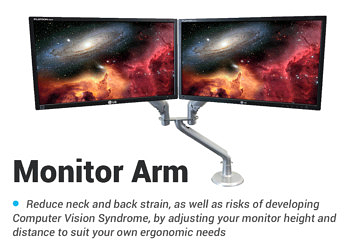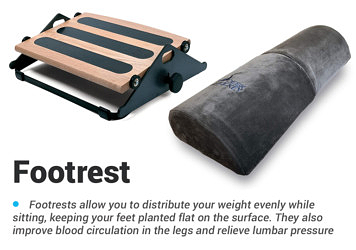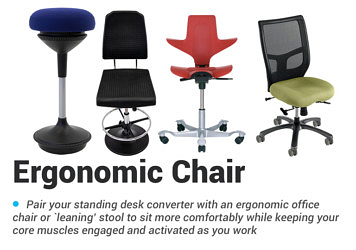Elevate II Adjusta Stand Up Desk Review
- Lab tested
Like most reviews sites, our editorial staff and laboratory testing expenses are partially offset by earning small commissions (at no cost to you) when you purchase something through those links. Learn More

Overview
| Review Summary |
Anthro’s Elevate II Adjusta combines the standard Elevate II desk with a separate, independently-adjustable keyboard tray platform. This feature, seldom found on adjustable height desks, turns an otherwise ordinary desk into a unique ergonomic workstation. Aside from this second platform, the Adjusta shares its predecessor’s features, as well as its shortcomings, so it’s hard to recommend the Adjusta without a few caveats. |
|---|---|
| Warranty |
Table top: Lifetime warranty |
| Lift Type |
Electric |
| Transit Speed |
1.5″/sec |
| Controller |
2-button controller |
| Sizes Available |
41.5″ x 48″ |
| Colors Available |
Black, Maple, Wenge |
| Adjustment Range |
28″-47″ |
| Weight Capacity |
150 lbs. |
| Noise Level |
48 dB |
| ANSI/BIFMA Certified |
No |
| Competition |
Compare to All Top-Rated Standing Desks
|
| Where to buy |
Buy on Amazon |
Rating
| Stability | |
|---|---|
| Safety | |
| Reliability | |
| Customer Experience | |
| Quality and Aesthetics | |
| Ergonomics | |
| Innovation | |
| Value | |
| Suitability for Treadmill Desking | |
| Positives | The Adjusta tray is spacious, and easily adjusts in height with a lever. It can be raised 7" above the desk, to compensate for the desk's low maximum height. 3D lamination is more attractive and more durable than standard laminates. |
| Negatives | Can't easily use a mouse when the keyboard tray is set at an angle. Tilt-and-Go wheels cause a tip-over risk. Features a low weight capacity. |
Bottom Line
Editor’s Note: After being acquired by Ergotron in 2015, which itself has since been acquired (and rumor had it, is on the market to be sold again) Anthro Furniture has been gradually disassembled and its original Portland headquarters and factory has been shuttered. These desks are no longer being produced but we leave our original view here for posterity.
Anthro is a Portland-based company with a storied, 30-year history as a manufacturer of technology-enabled furniture. They make specialized workbenches and charging carts as well as full-fledged radiology tables. They’ve traditionally catered to large organizations like schools and hospitals where heavy-duty, specialty furniture is needed. In 2015, Anthro was purchased by Ergotron, one of the largest companies in the office ergonomics marketplace, whose LX monitor arm and Workfit-S desktop converter are some of the best in their respective categories.
Since this purchase, Anthro has been making inroads into more typical offices. Their made-in-America Elevate II was their first simple, no-frills desk designed for regular offices. The Elevate II Adjusta builds on the same foundation as the Elevate II, but adds a separately-adjustable, ergonomic keyboard platform for an improved typing experience. Coupled with the Elevate II’s signature, albeit ill-conceived, Tilt-and-Go wheels, this new tray definitely sets the Elevate II Adjusta apart from other desks on the market.
Assembly

The Adjusta’s assembly process is more daunting than that of your typical desk. The installation guide is partly to blame: Many of the included illustrations are difficult to parse, and installation involves a dizzying array of different parts. On top of that, assembling the Adjusta’s keyboard platform includes a few bewildering components that can challenge even the most seasoned desk assembler.
Thankfully, Anthro did a couple of things to make the whole assembly process a bit easier. Rather than throwing in the typical “disposable” tools you usually get when you have to assemble furniture—tiny hex keys and wrenches that deform as soon as you hit a tight screw hole—the tools provided with the Adjusta are of a superior quality, and, thanks to touches like actual handles, easier to use. Also helpful is the fact that the Adjusta’s table comes with pre-drilled holes for attaching the base and the keyboard tray mechanism to the table top.
One peeve we have with the Elevate II’s assembly process is that the leg isn’t fastened to the desk top directly like a normal desk. Instead, Anthro’s designers included the odd step of setting the leg on top of the top arm, unfastened, and fitting a metal housing over the leg’s motor base. This housing is what ultimately gets attached to the top arm and to the desk top. The problem is that even with the housing tightly screwed down, there was still enough wiggle room between the leg and the table top to cause the leg to skew to the wrong angle and make the desk crooked. We had to manually adjust the legs and the housing brackets with a level to ensure the legs were truly perpendicular to the floor. Even now, some of us have a sneaking suspicion that the desk is crooked again.
Most desk manufacturers make their table tops out of engineered woods like MDF—for desks in particular, these wood products function just as well as natural wood, and are much cheaper to make. To lend these manufactured tops better aesthetic appeal, many desk manufacturers adhere a sheet of high-pressure laminate to the table top, then use a process called edge banding to—you guessed it—glue a laminated band around the desk’s edges. The result is often the kind of cheap-looking top you’ve seen in classrooms and cafeterias across the country. This lamination process also tends to succumb to moisture damage and peel away over time, reducing the life of your furniture and making the top more susceptible to damage like warping.
Luckily, Anthro doesn’t do that. Instead, the Elevate II Adjusta uses a superior lamination technique called 3D lamination to finish their desk tops. This method uses extreme heat and pressure to wrap the table top in a single, unbroken piece of laminate—even over the corners and edges. In addition to better protecting the table top from moisture damage and abrasion, it creates a sleek, unbroken finish that looks a lot more like natural hardwood than the typical fare manufacturers churn out. Advanced 3D lamination isn’t super common—the only other desk manufacturer we’ve reviewed who uses it is iMovR—but it really is impressive. People are often surprised to find out that the 3D-laminated top they’re looking at isn’t actually natural wood.
Another benefit to 3D lamination is that it lets Anthro create an ergo-contoured front edge for the Adjusta’s keyboard tray. It’s gently sloped to be comfortable enough to lean on, and is curved to make it easier to reach your mouse and anything else on the tray.
The Adjusta’s table top is available in three finishes: Black, Maple, and Wenge (a dark-brown woodgrain). There are only two sizes to choose from: 41.5″ x 48″ and 41.5″ x 60″. We’re disappointed by the Adjusta’s limited variety of options, which makes it hard to find the right configuration for your office.
Performance
 The Adjusta’s electric base is similar to other adjustable height desks. A simple two-button controller adjusts the desk’s height, and the desk moves at a speed of 1.5″ per second, fast enough for all but the most impatient users. Its motors hum at a decent 48dB during height adjustment which, while not exactly whisper-silent, is still an acceptable noise level—we’ve tested desks that sound like coffee grinders. The Adjusta is thankfully not loud enough to be disruptive.
The Adjusta’s electric base is similar to other adjustable height desks. A simple two-button controller adjusts the desk’s height, and the desk moves at a speed of 1.5″ per second, fast enough for all but the most impatient users. Its motors hum at a decent 48dB during height adjustment which, while not exactly whisper-silent, is still an acceptable noise level—we’ve tested desks that sound like coffee grinders. The Adjusta is thankfully not loud enough to be disruptive.
Like the Elevate II, the Adjusta suffers from a very meager weight capacity of 150 lbs. In fact, the only other electric desk we’ve seen with that lifting capacity is the Ikea Bekant. At first glance you might think that 150 lbs. is plenty for an adjustable-height desk, since most folks aren’t loading the desk with anything heavier than their computers. The truth is that published weight ratings assume an evenly-distributed weight across the desk top. In reality desks tend to be weighed down in a small area, typically where the PC tower and monitors are. To overcome this uneven load distribution, electric desks need reliably strong motors. Weight capacity over 200 (or even better, over 300) is a good indicator that motors are sufficiently powered and reliable enough to avoid failing after a year.
Giant Keyboard Tray
By far the most interesting feature on the Adjusta is its built-in ergonomic keyboard tray. Keyboard trays provide an ergonomic boon to office workers by allowing them to type with their arms at a negative angle (namely, hands pointed toward the floor), keeping your arms and wrists relaxed and protecting them from the strain of typing all day. We’ve seen integrated keyboard trays before on iMovR’s Omega models (Everest, Olympus, and Denali), but this is the first adjustable-height desk we’ve seen with a keyboard tray that spans the width of the desk top.
To adjust the keyboard tray, simply press a lever mounted underneath the keyboard tray. This releases the tray, which you can then set to the proper height. Loosen a separate knob to set the platform’s angle anywhere between 9 and -15 degrees, and tighten the knob again to lock this angle in place. Be wary though—this knob isn’t very secure, and simply leaning on the keyboard tray is enough to unintentionally change the tray’s angle.
This integrated keyboard tray improves upon many of the Elevate II’s shortcomings to make the Adjusta a much better desk. For one, we found Adjusta less likely to slide out of place than the standard Elevate—the extra weight of the tray keeps the desk rooted in place. And because the keyboard platform adds 12.5 inches of depth to the desk, Anthro had the forethought to make the Adjusta’s feet longer to compensate, the upshot of which is that the desk has more support and is less likely to accidentally tip over.

Arguably the most impressive thing about the Adjusta’s keyboard platform is its ability to rise up to 7 inches above the desk, raising its max height to 54 inches. This improves the Elevate II’s stability: It uniquely allows the Adjusta to reach heights usually reserved for desks with three-segment lifting legs while maintaining the extra stability a two-segment lifting leg provides. Fewer segments means fewer points of instability, leading to a more stable desk overall. The extra height also makes the Adjusta more suitable as a treadmill desk than its basic counterpart. While the standard Elevate II’s height adjustment range of 28″ to 47″ is within ANSI/BIFMA standards, it fails to take into account the extra 5 – 6″ height of the treadmill. If you’re looking for a treadmill desk workstation, the Adjusta will serve you better than the Elevate II.
Of course, that’s not to say the Adjusta’s tray is without weaknesses. The keyboard tray doesn’t provide a dedicated platform for your mouse. With the tray adjusted to an ergonomic angle of -15 degrees, there’s nothing to keep it from sliding off the surface, so we recommend pairing the keyboard tray with a trackball or touch pad instead. The keyboard tray makes the rest of the desk more difficult to access, so unless you have preternaturally long arms, you may have to position your phone and PC tower closer to you to compensate. Similarly, if you plan on setting the keyboard tray higher than the desk top, you will need an even taller monitor arm to keep your screens at a height you can comfortably see.
Other Features
The built-in keyboard tray is the Adjusta’s biggest feature, but it’s not the only one. Like the standard Elevate II, the Adjusta comes with a metal cable trough to help keep your workstation tidy by collecting cords and surge protectors. The Adjusta also features unique “Tilt-and-Go” wheels embedded under the back of each foot. These wheels allow you to move the desk around by tilting it backwards and pushing or pulling the desk.
We’ve seen wheeled desks before—many of iMovR’s desks, as well as the Mod-E and ModTable, are available with caster wheels. But tilting a desk back to move it? That’s a first. And we’re not impressed. Tilting a desk back is a relatively easy with a bare desk top. But once you’ve loaded the desk with your laptop, monitors, keyboard, mouse, and tower, tilting it in any way becomes a very, very, very bad idea.
Another consequence of these wheels is that, without the grippy foot pads of other desks, the Adjusta is liable to slide out of place when you bump into it. This is less of a problem on the Adjusta than on the regular Elevate, as the extra weight of the Adjusta’s larger feet and table help to anchor it better, but we still recommend propping the desk against a wall to keep it still. Of course, none of this would be too big an issue if the “Tilt-and-Go” wheels were optional. But unfortunately, the wheels are a permanent fixture; there’s no option to get an Adjusta without them.
Other desks offer the option of a set of four caster wheels, which makes them easy to reposition without creating a tipping hazard in the process. The best mobile desks use locking caster wheels to keep the desk in place when you don’t want it to move. The Elevate II’s Tilt-and-Go wheels, on the other hand, are much more trouble than they’re worth.
The Takeaway
A suite of unique features definitely make Anthro’s Adjusta a standout from the typical adjustable-height desk. Its integrated keyboard tray—by all accounts a completely separate, independently-adjustable platform—provides an elegant solution to a user’s wrist ergonomics. Its independent height adjustment range gives users a greater degree of customization, in addition to making up for the Elevate II’s low height range. But while this keyboard tray can adjust to a more natural typing angle, doing so renders the platform incompatible with accurate mouse work. Additionally, the Adjusta shares the standard Elevate II’s largest weaknesses: a worryingly low lifting capacity and ill-conceived “Tilt-and-Go” wheels. More mobile workers who need a wheeled desk and a separate typing platform may appreciate the Adjusta’s wheels and adjustable keyboard tray. But its high price, coupled with its average performance specs, makes the desk less of a surefire value for other prospective desk buyers.






0 Comments
Leave a response >